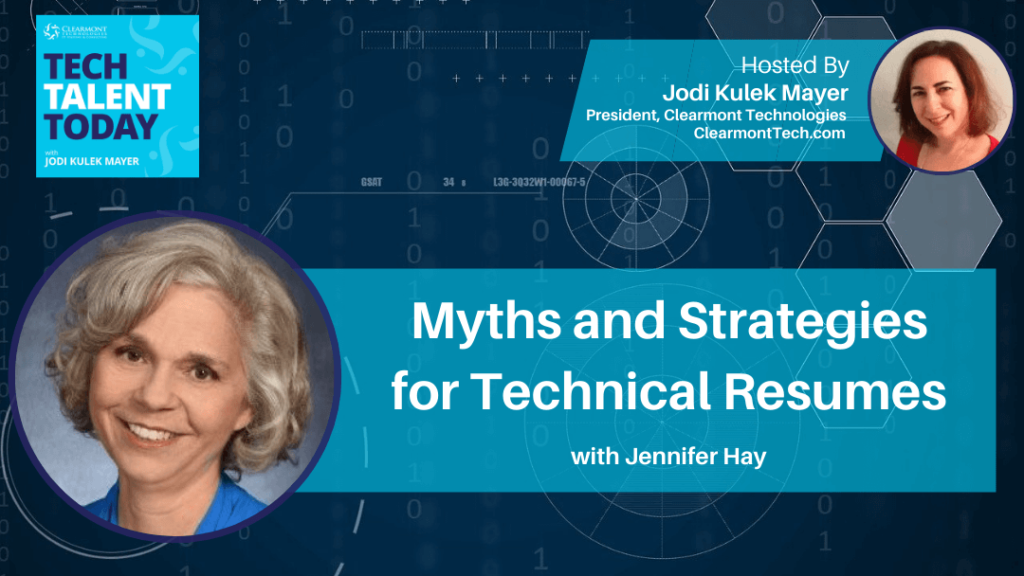In this episode of Tech Talent Today, I’m excited to be joined by Jennifer Hay. Jennifer has been writing technical resumes and LI profiles for IT professionals for over 15 years. She has several certifications, including Academy Certified Resume Writer, Resume Writing Specialist in Information Technology, and Certified Professional Resume Writer. Her background is in IT, BI, and Data and Information Management, so she loves to hear about all the innovative things people have done. Listen to learn the unique aspects of writing a technical resume.
You will want to hear this episode if you are interested in…
- Technical resumes for all audiences [02:48]
- Including the right information [05:26]
- The challenge with cover letters [09:39]
- What is career storytelling? [14:19]
- Writing a branding statement [17:41]
- Maximizing a LinkedIn profile [22:11]
- Advice for IT consultants [26:31]
What to include in your technical resume
One of the unique challenges with technical resumes is blending the technology with the technical details and relating that to business or technical value. Many people focus too much on the tools they have used. While that information is necessary, other aspects need to be included to appeal to the reader, whether they are a technical manager or someone in the HR department.
A one-page resume isn’t realistic for a technical professional. Typically, the resume should be about two pages, highlighting project efforts and accomplishments that concisely highlight personal strengths. Deciding what to include can be difficult for someone who has worked on many different projects, so focusing on the last six or seven years is a place to start. Recruiters often want to focus on accomplishments from the previous year, but that isn’t practical for a complete picture of the candidate.
While six or seven years is a good baseline, there are times when prior experience is necessary to include. It can be beneficial to incorporate lessons learned from an earlier career path or a project that was pivotal to one’s career. References to technology should be removed from these older experiences because the technology is likely out of date. One good thing to emphasize for each of these previous experiences is what difference they made. All this information needs to be conveyed in a way that’s easily consumable since resumes are often scanned over quickly.
Cover letters and summaries
Recruiters tend not to have time to read cover letters. So a cover letter isn’t often necessary unless a company asks for one. The letter needs to be short, concise, and highly targeted to the position. The company’s website can be a great place to find out what’s important to the company. Press releases, case studies, and generally covered topics are things to include in a cover letter that would leave a lasting impression.
The parameters are similar for the summary paragraph at the top of a resume. It needs to be short and precise, including strengths without fabricating or exaggerating achievements. Using a paragraph from generic resume samples doesn’t do any good for standing out. The summary needs to position the individual for the next career move by highlighting relevant roles for the desired position. For those in IT, their job title alone probably doesn’t convey what they actually do because technical professionals often take on additional roles and responsibilities. That information needs to be made clear.
Career storytelling
When they talk about career storytelling, most people are referring to the trials and challenges throughout a career. Effective career storytelling starts with project storytelling. When writing a resume, the journey to that point in a career is equally as important as the end result of obtaining a position. Describing the journey provides the opportunity to talk about the leadership skills assumed and the expanded roles and responsibilities.
The career storytelling portion of Jennifer’s website provides examples of how stories can translate into a resume. It’s good to see how a general narrative about work can be created into something more attractive in a resume. Jennifer’s website shows a practical, step-by-step guide on sharing those stories on a resume. The website asks questions to get people thinking about their strengths and evaluating what they want to do next.
Branding is something that needs to carry over into a cover letter and LinkedIn profile. #LinkedInProfile #Branding Share on XResources & People Mentioned
Connect with Jennifer Hay
Connect With Jodi Kulek Mayer
- https://clearmonttech.com/about/meet-the-team/
- Follow Jodi on LinkedIn
Subscribe to Tech Talent Today on
Apple Podcasts, Spotify, Google Podcasts
Audio Production and Show notes by
PODCAST FAST TRACK
https://www.podcastfasttrack.com

